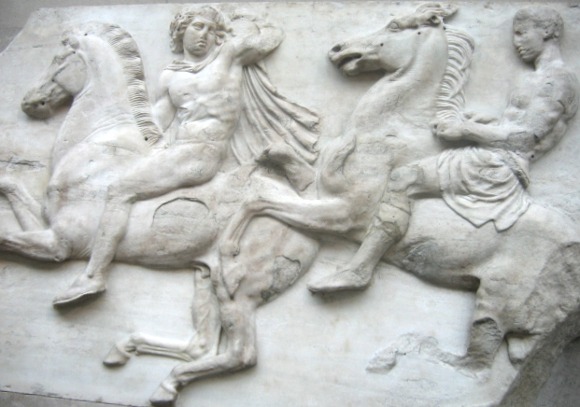John Keats, selected poems Contents
On Seeing the Elgin Marbles: Imagery, symbolism and themes
Imagery and symbolism in On Seeing the Elgin MarblesMortal/immortalSickness and disorientationNatural imagesThemes in On Seeing the Elgin MarblesThe worth of human artistryEnlightened attitudes to culture
Imagery and symbolism in On Seeing the Elgin Marbles
Mortal/immortal
The Marbles symbolise the wonders of human creativity and their ability to outlive their creators. However, this symbolism is complex:
- The artistry of the Marbles is a ‘wonder’ and conveys a strong sense of ‘Grecian grandeur’
- The sculptures are also a reminder that everything is subject to the wasting effects of ‘old Time’
- Simultaneously, therefore, the Marbles symbolise mortality and immortality.
 Sickness and disorientation
Sickness and disorientation
Keats uses images of sickness when describing his feelings. He feels like ‘a sick eagle’, a bird of immense power and grandeur, the symbol of freedom and aspiration, which has been brought low. In being sick all its potential is destroyed.
He also refers to the ‘dizzy pain’ he feels when contemplating the contradictions about immortality and change inherent in the Marbles, and his ‘indescribable’ mental ‘feud’.
Natural images
The ‘billowy main (sea)’ is a powerful image of the relentless dynamism of our planet, as well as emphasising the vulnerability of the Marbles as they were taken to Britain by ship. The sun may stand for the power and permanence of Nature, as well as reflecting the golden sunshine of Greece under which the Marbles were originally created, yet it is swiftly followed by shadow, just as clouds negate the power and warmth of sunshine.
The final idea, ‘a shadow of a magnitude’, captures our sense that something exists on a plane beyond that which can be observed: the conception of something so great that it can barely be grasped. All these natural phenomena, although themselves mutable, have a greater permanence and magnitude than the humanly constructed, decaying Marbles.
Investigating imagery and symbolism in On Seeing the Elgin Marbles
- Do you agree that the symbolism of the Marbles is complex?
- What are the various symbolic meanings that they generate?
- Why does Keats use images of sickness to describe his feelings?
- Why should he feel ‘dizzy pain’ when contemplating the Marbles?
Themes in On Seeing the Elgin Marbles
The worth of human artistry
The poem is a reflection on the pleasures and the pains of human creativity. The Marbles represent the best of human imagination. They are ‘glories of the brain’ that have endured through time - yet even they are subject to the wasting effects of time, displacement and decay.
As in so much of his poetry, Keats is fascinated and disturbed by the fact that art can have such sharply contrasting effects: the beauty inspires and moves, but it also reminds him that everything is subject to change – and he feels his own mortality especially keenly when confronted by them, conscious that their beauty will remain long after his death. Might his mental battle be about whether it was worth devoting himself to creating something that either might not survive or, conversely, would be all that remained of a vanished life?
Enlightened attitudes to culture
The Marbles are emblems of a culture to which Keats (and many of his friends in the Leigh Hunt circle) thought it was noble to aspire. The infusion of such art works from Ancient Greece could only strengthen and enrich British culture.
An underlying theme to Keats’ admiration is his identification with the beliefs and values which led to the Marbles being brought to Britain and publicly exhibited: values which mixed artistic considerations with liberal politics.
Investigating themes in On Seeing the Elgin Marbles
- What is Keats saying about the worth of human artistry?
- Explain how the poem conveys the idea that art can both move with its beauty and disturb by its tendency to remind us of our own mortality.
- In what ways is classical culture itself a theme of this sonnet?
- What cultural beliefs and values are epitomised by the Marbles and by their acquisition for the British Museum?
Something which represents something else through an association of ideas.
Related material
Scan and go
Scan on your mobile for direct link.